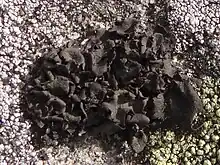Umbilicaria polyphylla
Umbilicaria polyphylla, commonly known as petaled rock tripe,[2] is a widely distributed species of saxicolous lichen in the family Umbilicariaceae. It was first described by Carl Linnaeus in his 1753 work Species Plantarum as Lichen polyphyllus. German botanist Johann Christian Gottlob Baumgarten transferred it to the genus Umbilicaria in 1790. The lichen has a dark brown to black thallus that measures 2–6 cm (0.8–2.4 in) in diameter. The upper surface is smooth, while the lower surface is sooty black. It grows on exposed rocks, typically in arctic-alpine habitats.[2]
| Umbilicaria polyphylla | |
|---|---|
 | |
| Scientific classification | |
| Domain: | Eukaryota |
| Kingdom: | Fungi |
| Division: | Ascomycota |
| Class: | Lecanoromycetes |
| Order: | Umbilicariales |
| Family: | Umbilicariaceae |
| Genus: | Umbilicaria |
| Species: | U. polyphylla |
| Binomial name | |
| Umbilicaria polyphylla | |
| Synonyms[1] | |
| |
In Iceland, it has the conservation status of a vulnerable species (VU).[3]
References
- "Synonymy: Umbilicaria polyphylla (L.) Baumg". Species Fungorum. Retrieved 12 February 2021.
- Brodo, Irwin M.; Sharnoff, Sylvia Duran; Sharnoff, Stephen (2001). Lichens of North America. Yale University Press. p. 706. ISBN 978-0300082494.
- Náttúrufræðistofnun Íslands [Icelandic Institute of Natural History] (1996). Válisti 1: Plöntur. (in Icelandic) Reykjavík: Náttúrufræðistofnun Íslands.
This article is issued from Wikipedia. The text is licensed under Creative Commons - Attribution - Sharealike. Additional terms may apply for the media files.